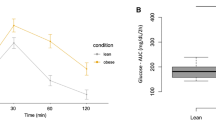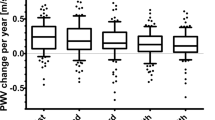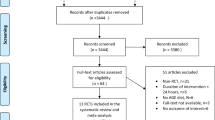Abstract
Objective:
The increased cardiovascular (CV) disease risk in patients with morbid obesity (MO) cannot be fully explained by traditional CV risk factors. Activation of the receptor of Advanced Glycation Endproducts (RAGE) leads to inflammation via the NF κβ (nuclear factor κβ) pathway. The soluble form of RAGE (sRAGE), which is present in plasma, can bind to ligands of RAGE and avoids interaction of RAGE with proinflammatory ligands. We investigated sRAGE levels in patients with MO and compared them with healthy lean controls (CO), before and after bariatric surgery.
Design:
We conducted a cross–sectional study and a 24-month longitudinal study.
Subjects:
We included 85 patients (mean age: 41±12 years; mean body mass index (BMI): 45.4±7.9 kg m−2) with MO in comparison with 40 CO (mean age: 42±13 years; mean BMI: 26.0±5.5 kg m−2). All patients were investigated before and 2 years after bariatric surgery. Apart from weight and CV risk markers (blood pressure, lipids), a glucose tolerance test (75 g), renal and inflammation parameters were assessed. sRAGE levels were assessed by a commercial ELISA. To investigate the associations of the observed reductions of values, delta (Δ) of parameters were calculated.
Results:
Patients with MO had significant lower sRAGE levels than CO: 1010±514 vs 1501±674 pg ml−1; P<0.001. In the longitudinal study, sRAGE levels increased significantly after bariatric surgery from 1010±514 to 1261±710 pg ml−1; P=0.008. In the correlation analysis, ΔsRAGE levels were associated with Δ1-h and Δ2-h postprandial glucose, Δfasting insulin, Δ2-h postprandial insulin, ΔHOMA (homeostatic model assessment)-insulin resistance (ΔHOMA-IR), Δγ-glutamyl transferase and Δtriglycerides. In a multivariate model, Δ1-h and Δ2-h postprandial glucose, Δ2-h postprandial insulin and ΔHOMA-IR predicted ΔsRAGE.
Conclusion:
Patients with MO have significantly lower sRAGE levels compared with non-obese CO, but sRAGE levels increase significantly after weight loss induced by bariatric surgery. As high sRAGE levels inhibit the activation of inflammatory pathways, our results might help understand the beneficial effects of bariatric surgery regarding CV morbidity and mortality.
This is a preview of subscription content, access via your institution
Access options
Subscribe to this journal
Receive 12 print issues and online access
$259.00 per year
only $21.58 per issue
Buy this article
- Purchase on Springer Link
- Instant access to full article PDF
Prices may be subject to local taxes which are calculated during checkout

Similar content being viewed by others
References
Singh R, Barden A, Mori T, Beilin L . Advanced glycation end-products: a review. Diabetologia 2001; 44: 129–146.
Bucciarelli LG, Wendt T, Rong L, Lalla E, Hofmann MA, Goova MT et al. RAGE is a multiligand receptor of the immunoglobulin superfamily: implications for homeostasis and chronic disease. Cell Mol Life Sci 2002; 59: 1117–1128.
Basta G, Lazzerini G, Massaro M, Simoncini T, Tanganelli P, Fu C et al. Advanced glycation end products activate endothelium through signal-transduction receptor RAGE: a mechanism for amplification of inflammatory responses. Circulation 2002; 105: 816–822.
Lindsey JB, deLemos JA, Cipollone Ayers CR, Rohatgi A, Morrow DA, Khera A et al. Association between circulating soluble receptor for advanced glycation end products and atherosclerosis: observations from the Dallas Heart Study. Diabet Care 2009; 32: 1218–1220.
Humpert PM, Kopf S, Djuric Z, Wendt T, Morcos M, Nawroth PP et al. Plasma sRAGE is independently associated with Urinary Albumin Excretion in Type 2 Diabetes. Diabet Care 2006; 29: 1111–1113.
Falcone C, Emanuele E, D’Angelo A, Buzzi MP, Belvito C, Cuccia M et al. Plasma Levels of Soluble Receptor for Advanced Glycation End Products and Coronary Artery Disease in Nondiabetic Men. Arterioscler Thromb Vasc Biol 2005; 25: 1032–1037.
Yonekura H, Yamamoto Y, Sakurai S, Petrova RG, Abedin MJ, Li H et al. Novel splice variants of the receptor for advanced glycation end-products expressed in human vascular endothelial cells and pericytes, and their putative roles in diabetes- induced vascular injury. Biochem J 2003; 370: 1097–1099.
Raucci A, Cugusi S, Antonelli A, Barabino SM, Monti L, Bierhaus A et al. A soluble form of the receptor for advanced glycation endproducts (RAGE) is produced by proteolytic cleavage of the membrane-bound form by the sheddase a disintegrin and metalloprotease 10 (ADAM10). FASEB J 2008; 22: 3716–3727.
Bierhaus A, Nawroth PP . Multiple levels of regulation determine the role of the receptor for AGE (RAGE) as common soil in inflammation, immune responses and diabetes mellitus and its complications. Diabetologia 2009; 52: 2251–2263.
Geroldi D, Falcone C, Emanuele E, D'Angelo A, Calcagnino M, Buzzi MP et al. Decreased plasma levels of soluble receptor for advanced glycation end-products in patients with essential hypertension. J Hypertens 2005; 23: 1725–1729.
Katakami N, Matsuhisa M, Kaneto H, Matsuoka TA, Sakamoto K, Yasuda T et al. Serum endogenous secretory RAGE level is an independent risk factor for the progression of carotid atherosclerosis in type 1 diabetes. Atherosclerosis 2009; 204: 288–292.
Santilli F, Bucciarelli L, Noto D, Cefalù AB, Davì V, Ferrante E et al. Decreased plasma soluble RAGE in patients with hypercholesterolemia: effects of statins. Free Radical Biol Med 2007; 43: 1255–1262.
Emanuele E, D'Angelo A, Tomaino C, Binetti G, Ghidoni R, Politi P et al. Circulating levels of soluble receptor for advanced glycation end products in Alzheimer disease and vascular dementia. Arch Neurol 2005; 62: 1734–1736.
Yilmaz Y, Ulukaya E, Gul OO, Arabul M, Gul CB, Atug O et al. Decreased plasma levels of soluble receptor for advanced glycation endproducts (sRAGE) in patients with nonalcoholic fatty liver disease. Clin Biochem 2009; 42: 802–807.
Basta G, Sironi AM, Lazzerini G, Del Turco S, Buzzigoli E, Casolaro A et al. Circulating soluble receptor for advanced glycation end products is inversely associated with glycemic control and S100A12 protein. J Clin Endocrinol Metab 2006; 91: 4628–4634.
Geroldi D, Falcone C, Minoretti P, Emanuele E, Arra M, D'Angelo A . High levels of soluble receptor for advanced glycation end products may be a marker of extreme longevity in humans. J Am Geriatr Soc 2006; 54: 1149–1150.
Norata GD, Garlaschelli K, Grigore L, Tibolla G, Raselli S, Redaelli L et al. Circulating soluble receptor for advanced glycation end products is inversely associated with body mass index and waist/hip ratio in the general population. Nutr Metab Cardiovasc Dis 2009; 19: 129–134.
Yamagishi S, Adachi H, Nakamura K, Matsui T, Jinnouchi Y, Takenaka K et al. Positive association between serum levels of advanced glycation end products and the soluble form of receptor for advanced glycation end products in nondiabetic subjects. Metabolism 2006; 55: 1227–1231.
Nakamura K, Adachi H, Matsui T, Kurita Y, Takeuchi M, Yamagishi S . Independent determinants of soluble form of receptor for advanced glycation end products in elderly hypertensive patients. Metabolism 2009; 58: 421–425.
Colhoun HM, Betteridge DJ, Durrington P, Hitman G, Neil A, Livingstone S et al. Total soluble and endogenous secretory receptor for advanced glycation endproducts as predictive biomarkers of coronary heart disease risk in patients with type 2 diabetes: An analysis from the CARDS Trial. Diabetes 2011; 60: 2379–2385.
Tam XH, Shiu SW, Leng L, Bucala R, Betteridge DJ, Tan KC . Enhanced expression of receptor for advanced glycation end-products is associated with low circulating soluble isoforms of the receptor in Type 2 diabetes. Clin Sci (Lond) 2011; 120: 81–89.
World Health Organization. The global challenge of obesity, 2002; Available from: http://www.who.int/dietphysicalactivity/en/ (accessed on 2 January 2007).
Kopp HP, Krzyzanowska K, Schernthaner GH, Kriwanek S, Schernthaner G . Relationship of androgens to insulin resistance and chronic inflammation in morbidly obese premenopausal women: studies before and after vertical banded gastroplasty. Obes Surg 2006; 16: 1214–1220.
Matthews DR, Hosker JP, Rudenski AS, Naylor BA, Treacher DF, Turner RC . Homeostasis model assessment: insulin resistance and beta-cell function from fasting plasma glucose and insulin concentrations in man. Diabetologia 1985; 28: 412–419.
Dupont WD, Plummer WD . Power and sample size calculations: a review and computer program. Controlled Clinical Trials 1990; 11: 116–128.
Basta G, Schmidt AM, De Caterina R . Advanced glycation end products and vascular inflammation: implications for accelerated atherosclerosis in diabetes. Cardiovasc Res 2004; 63: 582–592.
Hanford LE, Enghild JJ, Valnickova Z, Petersen SV, Schaefer LM, Schaefer TM et al. Purification and characterization of mouse soluble receptor for advanced glycation endproducts (sRAGE). J Biol Chem 2003; 279: 50019–50024.
Bucciarelli LG, Wendt T, Qu W, Lu Y, Lalla E, Rong LL et al. RAGE blockade stabilizes established atherosclerosis in diabetic apolipoprotein E-null mice. Circulation 2002; 106: 2827–2835.
Basta G, Leonardis D, Mallamaci F, Cutrupi S, Pizzini P, Gaetano L et al. Circulating soluble receptor of advanced glycation end product inversely correlates with atherosclerosis in patients with chronic kidney disease. Kidney Int 2010; 77: 225–231.
Chiang KH, Huang PH, Huang SS, Wu TC, Chen JW, Lin SJ . Plasma levels of soluble receptor for advanced glycation end products are associated with endothelial function and predict cardiovascular events in nondiabetic patients. Coron Artery Dis 2009; 20: 267–273.
Montaner J, Perea-Gainza M, Delgado P, Ribó M, Chacón P, Rosell A et al. Etiologic diagnosis of ischemic stroke subtypes with plasma biomarkers. Stroke 2008; 39: 2280–2287.
Yokota C, Minematsu K, Tomii Y, Naganuma M, Ito A, Nagasawa H et al. Low levels of plasma soluble receptor for advanced glycation end products are associated with severe leukoaraiosis in acute stroke patients. J Neurol Sci 2009; 287: 41–44.
Hudson BI, Moon YP, Kalea AZ, Khatri M, Marquez C, Schmidt AM et al. Association of serum soluble receptor for advanced glycation end-products with subclinical cerebrovascular disease: The Northern Manhattan Study (NOMAS). Atherosclerosis 2011; 216: 192–198.
Nin JWM, Ferreira I, Schalkwijk CG, Prins MH, Chaturvedi N, Fuller JH et al. Levels of soluble receptor for AGE are cross-sectionally associated with cardiovascular disease in type 1 diabetes, and this association is partially mediated by endothelial and renal dysfunction and by low-grade inflammation: the EURODIAB Prospective Complications Study. Diabetologia 2009; 52: 705–714.
Tam HL, Shiu SW, Wong Y, Chow WS, Betteridge DJ, Tan KC . Effects of atorvastatin on serum soluble receptors for advanced glycation end-products in type 2 diabetes. Atherosclerosis 2010; 209: 173–177.
Tan KCB, Chow WS, Tso AWK, Xu A, Tse HF, Hoo RLC et al. Thiazolidinedione increases serum soluble receptor for advanced glycation end-products in type 2 diabetes. Diabetologia 2007; 50: 1819–1825.
Adams TD, Stroup AM, Gress RE, Adems KF, Calle EE, Smith SC et al. Cancer Incidence and Mortality after Gastric Bypass Surgery. Obesity 2009; 17: 796–802.
Sjöström L, Gummesson A, Sjöström CD, Narbro K, Peltonen M, Wedel H et al. Effects of bariatric surgery on cancer incidence in obese patients in Sweden (Swedish Obese Subjects Study): a prospective controlled intervention trial. Lancet Oncol 2009; 10: 653–662.
Jiao L, Weinstein SJ, Albanes D, Taylor PR, Graubard BI, Virtamo J et al. Evidence that serum levels of the soluble receptor for advanced glycation endproducts are inversely associated with pancreatic cancer risk: a prospective study. Cancer Res 2011; 71: 3582–3589.
Yonekura H, Yamamoto Y, Sakurai S, Petrova RG, Abedin MJ, Li H et al. Novel splice variants of the receptor for advanced glycation end-products expressed in human vascular endothelial cells and pericytes, and their putative roles in diabetes-induced vascular injury. Biochem J 2003; 370: 1097–1109.
Koyama H, Shoji T, Yokoyama H, Motoyama K, Mori K, Fukumoto S et al. Plasma level of endogenous secretory RAGE is associated with components of the metabolic syndrome and atherosclerosis. Arterioscler Thromb Vasc Biol 2005; 25: 2587–2593.
Sjostrom L, Narbro K, Sjostrom CD, Karason K, Larsson B, Wedel H et al. Effects of bariatric surgery on mortality in Swedish obese subjects. N Engl J Med 2007; 357: 741–752.
Acknowledgements
We thank the Metabolic Staff of the Outpatients Department for Morbid Obesity of Rudolfstiftung Hospital, Vienna for their helpful work.
Author information
Authors and Affiliations
Corresponding author
Ethics declarations
Competing interests
The authors declare no conflict of interest.
Rights and permissions
About this article
Cite this article
Brix, J., Höllerl, F., Kopp, HP. et al. The soluble form of the receptor of advanced glycation endproducts increases after bariatric surgery in morbid obesity. Int J Obes 36, 1412–1417 (2012). https://doi.org/10.1038/ijo.2012.107
Received:
Revised:
Accepted:
Published:
Issue Date:
DOI: https://doi.org/10.1038/ijo.2012.107
Keywords
This article is cited by
-
Serum and follicular fluid levels of soluble receptor for advanced glycation end-products in women with and without polycystic ovary syndrome
Journal of Ovarian Research (2023)
-
Skin Autofluorescence and Carotid Intima-Media Thickness Evaluation Following Bariatric Surgery in Patients with Severe Obesity
Obesity Surgery (2021)
-
An inverse association between serum soluble receptor of advanced glycation end products and hyperandrogenism and potential implication in polycystic ovary syndrome patients
Reproductive Biology and Endocrinology (2017)
-
Lycopene supplementation reduces TNF-α via RAGE in the kidney of obese rats
Nutrition & Diabetes (2014)



